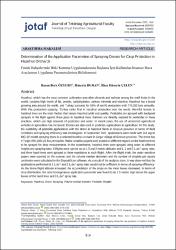| dc.contributor.author | Özyurt, Hasan Berk | |
| dc.contributor.author | Çelen, İlker Hüseyin | |
| dc.contributor.author | Duran, Hüseyin | |
| dc.date.accessioned | 2023-05-06T17:19:35Z | |
| dc.date.available | 2023-05-06T17:19:35Z | |
| dc.date.issued | 2022 | |
| dc.identifier.issn | 1302-7050 | |
| dc.identifier.issn | 2146-5894 | |
| dc.identifier.uri | https://doi.org/10.33462/jotaf.1105420 | |
| dc.identifier.uri | https://search.trdizin.gov.tr/yayin/detay/1144608 | |
| dc.identifier.uri | https://hdl.handle.net/20.500.11776/11868 | |
| dc.description.abstract | Hazelnut, which has the most common cultivation area after almonds and walnuts among the shell fruits in the world, contains high levels of fat, protein, carbohydrates, various minerals and vitamins. Hazelnut has a broad growing area around the world, and Turkey accounts for 58% of world production with 776,000 tons annually. With this production capacity, Turkey ranks first in hazelnut production over the world. Harmful insects in hazelnut trees are the main factors that reduce hazelnut yield and quality. Pesticides are sprayed with backpack sprayers in the fight against these pests in hazelnut trees. Farmers are directly exposed to pesticides in these practices, which use high amounts of pesticides and water. In recent years, the use of unmanned agricultural vehicles in agriculture has increased. Drones are also used in pesticide applications in agriculture. In this study, the suitability of pesticide applications with the drone in hazelnut fields in Giresun province in terms of field conditions and spraying efficiency was investigated. In September 2021, applications were made with DJI Agras MG-1P model spraying drone in a selected hazelnut orchard in Uzgur village of Giresun province. The drone has 4 Teejet XR11001VS fan jet nozzles. Water-sensitive papers were placed on different regions on the hazelnut trees to be sprayed for drop measurements. In the experiments, hazelnut trees were sprayed using water at different heights and spraying rates. 6 flights were carried out at 1.5 and 2 meters altitudes and 1, 2 and 3 L.da-1 spray rates, and three hazel trees were sprayed as three repetitions in each flight. After the flight trials, the water-sensitive papers were scanned on the scanner, and the volume median diameters and the number of droplets per square centimetre were calculated in the DepositScan software. As a result of the analyses done, it was observed that the applications performed at 1 L.da-1 and 2 L.da-1 spray rates would not be sufficient in terms of spraying efficiency. As the drone flight altitude increased, the accumulation of the drops on the inner leaves decreased. In terms of drop distribution, the most homogeneous application parameter was found to be 1.5 meters high above the upper leaves of the hazel trees and 3 L.da-1 spray rate. | en_US |
| dc.language.iso | eng | en_US |
| dc.identifier.doi | 10.33462/jotaf.1105420 | |
| dc.rights | info:eu-repo/semantics/openAccess | en_US |
| dc.subject | Hazelnut | en_US |
| dc.subject | Drone | en_US |
| dc.subject | Spraying | en_US |
| dc.subject | Volume median diameter | en_US |
| dc.subject | Pesticide | en_US |
| dc.subject | Droplet Fındık | en_US |
| dc.subject | İnsansız hava aracı | en_US |
| dc.subject | Drone | en_US |
| dc.subject | İlaçlama | en_US |
| dc.subject | Hacimsel ortalama çap | en_US |
| dc.subject | Pestisit | en_US |
| dc.subject | Damla | en_US |
| dc.title | Determination of the Application Parameters of Spraying Drones for Crop Production in Hazelnut Orchards | en_US |
| dc.type | article | en_US |
| dc.relation.ispartof | Tekirdağ Ziraat Fakültesi Dergisi | en_US |
| dc.department | Fakülteler, Ziraat Fakültesi, Biyosistem Mühendisliği Bölümü | en_US |
| dc.department | Fakülteler, Ziraat Fakültesi, Tarım Makinaları Bölümü | en_US |
| dc.identifier.volume | 19 | en_US |
| dc.identifier.issue | 4 | en_US |
| dc.identifier.startpage | 819 | en_US |
| dc.identifier.endpage | 828 | en_US |
| dc.institutionauthor | Özyurt, Hasan Berk | |
| dc.institutionauthor | Çelen, İlker Hüseyin | |
| dc.relation.publicationcategory | Makale - Ulusal Hakemli Dergi - Kurum Öğretim Elemanı | en_US |
| dc.identifier.trdizinid | 1144608 | en_US |



















